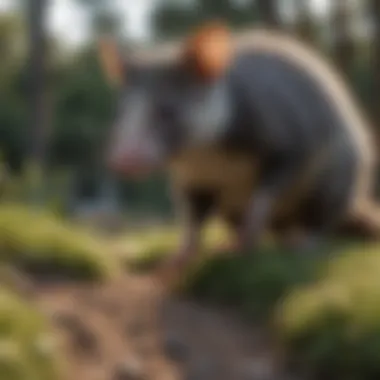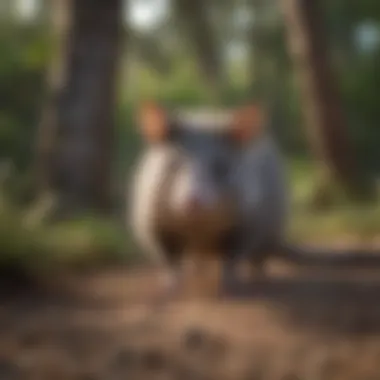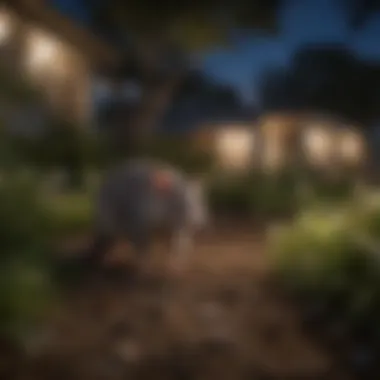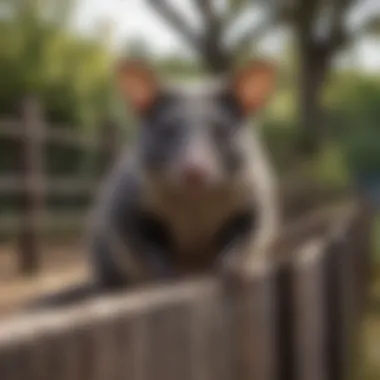Effective Strategies to Deter Possums from Your Yard


Intro
Possums, often misunderstood creatures, frequently invade residential yards in search of food and shelter. Understanding their behavior and natural tendencies can significantly aid in effective deterrence. In this guide, we will explore various strategies to keep possums at bay. We will delve into their unique characteristics, habitats, and recent scientific findings related to their biology. This comprehensive exploration aims to provide homeowners with informed strategies that promote coexistence while maintaining the integrity of outdoor spaces.
Fascinating Facts About the Animal
Unique Characteristics
Possums, or opossums, are the only marsupials found in North America. They exhibit distinct physical features, such as a prehensile tail and opposable thumbs on their hind feet, which aid in climbing and navigating their environments. Adult possums typically weigh between 8 to 14 pounds, with a body length of 24 to 33 inches. Their fur is gray and white, providing them with effective camouflage in their natural surroundings.
Extraordinary Abilities
These creatures are known for their unique defense mechanism—playing dead. When threatened, a possum may collapse and emit a foul odor, tricking predators into thinking it is deceased. In addition to this behavior, possums have an incredibly strong immune system, which makes them resistant to diseases such as rabies. This trait allows them to thrive in diverse environments, further complicating efforts to keep them away from residential areas.
Behavior and Habitat
Natural Habitats
Possums are adaptable animals, able to thrive in various environments, including forests, urban areas, and suburban neighborhoods. They prefer habitats that offer ample shelter and drinking water. Their diet is omnivorous, consisting of fruits, insects, and small animals, which often leads them to gardens and trash bins in search of food.
Social Structures
Though typically solitary, possums are generally non-aggressive. They tend to be nocturnal, venturing out at night to forage for food. Their social interactions are mainly limited to mating and rearing young, which often leads them to inhabit the same areas as other possums during breeding seasons.
Recent Scientific Discoveries
Latest Research Findings
Recent studies have shed light on possum behavior and ecology, revealing new insights into their adaptability to urban settings. Research indicates that possums can navigate complex landscapes, suggesting a much higher degree of intelligence than previously assumed. This intelligence enhances their ability to locate food sources while avoiding threats.
Breakthroughs in Animal Biology
Additionally, ongoing research focuses on the possum’s unique immune system. Scientists are studying its properties to potentially inform new medical therapies for humans, particularly in the context of infectious diseases. Understanding the biology of possums can deepen our knowledge of wildlife and its implications for ecosystem management.
Cultural Significance
Animals in Folklore
Possums have various cultural representations in folklore across different societies. They are often depicted as symbols of resilience and cleverness. Several indigenous groups have stories involving possums that highlight their role in maintaining balance within nature. This symbolic presence has contributed to their recognition beyond mere pests.
Influence on Art and Literature
In art and literature, possums often serve as muses, inspiring works that explore themes of survival, adaptability, and the complexities of nature. Their unique traits and behaviors lend themselves to narratives that resonate with themes of coexistence, prompting reflections on humanity’s relationship with wildlife.
Understanding the habits and characteristics of possums can enhance efforts to manage their presence in residential areas effectively.
In summary, comprehending the ecological and behavioral facets of possums is crucial for developing robust strategies to deter them from your yard. Through understanding, we can foster a more harmonious coexistence with these remarkable animals while safeguarding our outdoor spaces.
Understanding Possums
Understanding possums is crucial for developing effective strategies to keep them away from residential yards. Knowing their behavior and habitat needs can significantly reduce conflicts between possums and homeowners. Possums, native to various regions, often invade yards in quest for food or shelter. By comprehending their habits, one can proactively prevent their presence, ensuring the integrity of outdoor spaces.


Species Overview
Possums are marsupials belonging to the order Diprotodontia. They are commonly found in both urban and rural areas, adapting well to human environments. The Virginia opossum, the only marsupial native to North America, is particularly notable for its capacity to thrive in diverse habitats. With a size similar to domestic cats, they have a distinct appearance marked by long snouts, a prehensile tail, and a combination of gray and white fur.
Understanding the specific species of possums in your region can help tailor preventive measures. There are several species worldwide, each exhibiting unique behaviors and preferences. For instance, some possums may prefer wooded areas, while others might be more inclined to urban landscapes where food sources are readily available.
Habitat and Behavior
Possums generally prefer habitats that provide shelter and easy access to food. They typically nest in tree holes, attics, or garages. Understanding their nesting behaviors can help homeowners identify areas where possums may choose to inhabit. Possums are nocturnal creatures, active primarily at night. Their foraging habits mainly include scavenging for fruit, insects, and even human food leftovers.
By recognizing their preferred habitats, homeowners can take specific actions to minimize attractants and potential nesting sites. Regular monitoring of yards, especially during evening hours, can help in identifying possum activity early. This proactive approach can lead to better control over their presence.
Potential Risks and Benefits
While possums are often seen as pests, they play a significant role in the ecosystem. As scavengers, they help control insect populations and clean up carrion, which can reduce the spread of diseases. However, their presence can also present potential risks. Possums may carry parasites or diseases such as leptospirosis and tularemia, although these are rarely transmitted to humans.
Homeowners should carefully evaluate both the potential risks and benefits associated with possum activity. Implementing effective management strategies will focus on minimizing risks while acknowledging the ecological role of possums. Understanding this balance is essential for fostering coexistence while maintaining a healthy yard environment.
It's essential to recognize that managing wildlife conflicts requires a nuanced approach that respects both the creatures and the comfort of homeowners.
Recognizing Possum Activity in Your Yard
Recognizing possum activity in your yard plays a crucial role in keeping these nocturnal mammals at bay. Understanding their presence helps homeowners implement targeted strategies to deter them before they establish a territory. Early detection of possum activity not only preserves property aesthetics but also minimizes potential conflicts. Actively monitoring your yard for signs of possums allows for informed decision-making when it comes to prevention techniques.
Signs of Possum Presence
Identifying the signs of possum presence is essential. These cues can help you determine if possums are visiting your yard. Here are some key indicators:
- Tracks: Possums have unique paw prints. Measuring about two inches in length, their footprints show five toes, with a thumb-like digit. Look for these prints on soft soil or in garden beds.
- Scat: Possum droppings resemble those of cats, often containing remnants of their diet, like seeds or fur. Spotting their feces can confirm their activity.
- Nests: These marsupials may create nests in secluded spots. Check under decks, sheds, or dense shrubs for signs of their habitation.
- Nocturnal Sounds: Possums are active at night. Pay attention to rustling or chattering noises around your yard after sunset. These sounds may indicate possum movement.
- Damaged Plants: They sometimes feed on various vegetation. Chewed leaves or uprooted small plants could point to this nocturnal visitor.
By recognizing these signs, homeowners can respond quickly and efficiently, reinforcing their yard against unwanted invasions.
Identifying Their Habitats
Identifying the habitats where possums might thrive in your yard is paramount for effective prevention. Possums are adaptable creatures and can live in various environments. Here are some factors to consider when assessing potential habitats:
- Shelter: Possums seek shelter in areas with cover. This includes dense shrubs, piles of debris, or under structures like porches. Clearing these spaces can reduce their appeal.
- Water Sources: Possums are drawn to water. If your yard has standing water or a well-maintained birdbath, these could serve as attraction zones. Maintaining water sources can make your yard less appealing.
- Proximity to Other Wildlife: Areas near other wildlife may encourage possums to inhabit nearby settings. Rat or raccoon presence can lead to possum encroachments as they follow food sources.
- Food Availability: If your yard has accessible food, such as pet food left outside or food scraps in gardens, possums will likely be drawn to it. Evaluate your food storage habits to ensure nothing is tempting them.
Monitoring these elements within your yard not only helps in recognizing possum habitats but also aids in implementing strategies to prevent their establishment.
Prevention Strategies
Prevention strategies are critical steps in keeping possums away from your yard. These methods can help homeowners maintain their outdoor spaces without causing harm to wildlife. Effective prevention has multiple benefits. It limits property damage and reduces the likelihood of disease transmission from wild animals. Moreover, creating a barrier or deterrent is usually easier than responding to an existing infestation. This section discusses several practical strategies homeowners can implement to deter possums.
Exclusion Techniques
Securing Fencing
Securing fencing is a fundamental exclusion technique in the battle against possum intrusion. A key characteristic of effective fencing is its height and material. Fences should be at least four to six feet tall, ideally made from sturdy materials like wood or metal. Installing a fence that is too short or flimsy is not effective, as possums are adept climbers and can easily scale inadequate barriers. Furthermore, the unique feature of using an inwardly bent top can enhance its deterrent capability. This small adjustment prevents possums from jumping over the top. The primary advantage of securing fencing lies in its ability to act as a long-term solution. However, some disadvantages might include the installation costs and the potential visual impact on your yard.
Closing Off Potential Entry Points


Closing off potential entry points is equally crucial in preventing possums from entering your yard. Identifying gaps and openings is essential. Many homes have spaces under decks, porches, or sheds that can provide shelter to possums. A beneficial aspect of this strategy is that it requires minimal resources. Homeowners can use materials like wood, metal mesh, or even cement to seal these areas. This method is popular because it not only keeps possums out but can also prevent other pests. On the contrary, one disadvantage is the exhaustion of effort when the openings are numerous or hard to find. Still, addressing these entry points helps create an overall secure environment that is beneficial for homeowners.
Removing Food Sources
Proper Waste Management
Proper waste management is a vital strategy in reducing food sources for possums. Keeping garbage tightly sealed in bins is crucial. Possums are scavengers, and improperly managed waste attracts them. The key characteristic of an effective system is having bins that possums cannot open. Many homeowners opt for containers with locking lids, which drastically reduce the risk of opening. A unique feature of this approach is that it simultaneously enhances neighborhood hygiene and cleanliness. Proper waste management is an efficient and relatively low-cost tactic. However, the downside can be an increased effort in adhering to stricter practices, especially during outdoor gatherings.
Reducing Bird Feeders' Accessibility
Reducing bird feeders' accessibility is another effective method to deter possums from yards. Possums are opportunistic eaters and will not hesitate to raid bird feeders. A beneficial practice is to utilize feeders that are designed to prevent larger animals from accessing food. This often includes feeders that are suspended high, out of reach for most ground-dwelling animals. A unique aspect of this strategy is using squirrel-proof bird feeders, which tend to keep possums away as well. Some disadvantages include the need for a bit more effort in placing or maintaining the feeders, but the resulting lessened attraction to your yard is worth it.
Creating an Uninviting Environment
Utilizing Natural Deterrents
Utilizing natural deterrents can effectively create an uninviting environment for possums. These deterrents include scents that possums find distasteful, such as vinegar or citrus. A key characteristic of this approach is its non-toxic nature, making it safe for other animals and the environment. Many homeowners find this method beneficial because it avoids harsh chemicals. One unique feature is that natural deterrents are often inexpensive and easily accessible. A downside is that these methods may require repeated application, especially after rains or heavy winds, but they offer a gentle way of managing wildlife.
Maintaining Yard Cleanliness
Maintaining yard cleanliness is another essential element in deterring possums. Regularly clearing away debris, fallen fruits, or pet food will make your yard less appealing to them. A significant benefit of this strategy is that it promotes general yard health and aesthetics. Having a clean yard reduces harboring places for many pests including possums. The unique feature of this approach lies in its dual purpose of benefiting the appearance of your outdoor space. Some may find this method labor-intensive, but the long-term gains in yard maintenance outweigh the effort.
Behavioral Insights into Possums
Understanding the behavior of possums is crucial when considering effective methods to keep them away from residential areas. Recognizing how these creatures interact with their environments helps homeowners develop strategic approaches to deter them. This section delves into the preferences and natural behavior of possums, providing insights that can guide preventive actions for yard maintenance.
Understanding Possum Preferences
Possums have specific preferences that influence their foraging and nesting behaviors. They tend to thrive in environments that offer easy access to food, shelter, and little disturbance from human activity. Recognizing what attracts possums can greatly enhance one's ability to prevent their encroachment.
- Food Choices: Possums are opportunistic feeders. They eat fruits, vegetables, and insects, often scavenging through garbage or pet food. Securing these food sources is essential.
- Shelter Requirements: Possums prefer dens that provide shelter from harsh weather and potential predators. They utilize logs, bushes, and abandoned structures. Identifying and modifying potential hiding spots in yards will be helpful.
- Activity Patterns: These marsupials are nocturnal, which means they are most active at night. Understanding their timing can help homeowners detect possum presence through signs such as noise or disturbances.
Taking the time to understand possums’ food and shelter preferences is foundational in developing effective prevention strategies.
Utilizing Their Natural Behavior
Possums exhibit certain natural behaviors that can be proactively leveraged to establish deterrence. Understanding these behaviors can facilitate the creation of an environment that discourages their habitation.
- Instinctual Responses: Possums are known for their remarkable ability to play dead when threatened. This behavior typically indicates a preference for fleeing rather than fighting. Such instincts can be used to inform deterrent strategies that focus on unsettling their comfort and prompting movement.
- Solitary Nature: These animals prefer solitary living, often wandering alone in search of food. By creating barriers and managing resources that they find appealing, one can disrupt their typical solitary routines.
- Scent Marking: Possums use scent to communicate with each other. Introducing strong scents, such as citrus or ammonia, can act as natural deterrents by interfering with their ability to identify familiar territories.
By harnessing the natural behaviors of possums and understanding their preferences, homeowners can effectively keep these creatures at bay.
Behavioral insights are key to constructing an unwelcoming environment for possums, thus reducing the likelihood of these animals entering residential yards.
Wildlife Management Perspectives
Understanding wildlife management is crucial in creating sustainable strategies for dealing with possum invasions. This section emphasizes the importance of ethical and regulatory considerations in crafting effective responses to possum presence in residential areas. Rather than merely employing deterrents, homeowners can adopt a more comprehensive approach that respects ecological balance while discouraging possums from invading their yards.
Ethical Considerations
Ethically addressing possum management means recognizing their role in the local ecosystem. Possums can offer benefits, such as controlling pest populations and preventing ticks. Here are important points to think about:


- Respect for Wildlife: Actions against possums should not harm their populations unjustly.
- Humane Deterrents: It is essential to use humane strategies. These may include natural repellents or enclosing areas without causing injury.
- Education and Awareness: Informing the community about possum behavior is key. Awareness campaigns can guide residents in adopting the right mitigative practices that promote coexistence.
“Wildlife management is about balance. We must consider the ecosystem's role while ensuring privacy at home.”
Regulatory Framework
The regulatory framework surrounding wildlife management varies by location, and understanding these regulations is essential for effective possum control. It often includes:
- Local Laws: Homeowners should familiarize themselves with local laws regarding wildlife control and protection.
- Permitting for Deterrents: Some methods may require permits or specific approvals. Homeowners should verify this prior to action.
- Reporting Procedures: Knowing how to report possum overpopulation or invasive behavior can trigger effective community-wide responses.
Ensuring compliance with these regulations not only aids in the effective management of possums but also contributes to broader environmental protection initiatives.
Long-term Solutions for Coexistence
Finding strategies for coexistence with possums is essential for homeowners. Possums can bring both challenges and benefits to a yard. Developing solutions that allow humans and possums to share space peacefully is vital. Embracing long-term solutions can allow residents to protect their properties while appreciating the ecological role possums serve. The following sections provide strategies that can be implemented for effective coexistence.
Habitat Management Strategies
Habitat management is key in encouraging possums to remain in their natural environment rather than invading residential properties. Actions taken in this area can greatly influence possum behavior and movements. Here are some effective strategies:
- Creating Natural Barriers: Planting dense shrubbery or hedgerows can provide a natural barrier, making it less appealing for possums to enter yards. This can deter them from foraging through gardens or nests.
- Maintaining Native Flora: Utilizing plants native to the area can attract possums away from cultivated gardens. Possums tend to prefer native vegetation for food.
- Water Sources: Ensure to manage water sources effectively. Standing water can attract possums, so maintaining proper drainage and managing water accumulation is important.
- Avoid Over-Illuminating Your Yard: Bright outdoor lights may attract insects, which in turn can lure possums. Reducing light pollution will create a less inviting environment for them.
Healthy habitats within the neighborhood can lead to fewer possum encounters in yards.
Long-term habitat management not only makes yards less appealing to possums but also supports their natural behaviors.
Community-Based Approaches
Community involvement can significantly enhance the effort to coexist with possums. Collaborative strategies can lead to better outcomes for all residents. Consider these approaches:
- Educating Neighbors: Distributing information on possums' behavior and effective deterrents can foster a communal understanding. When neighbors work together, the community becomes less attractive overall to possums.
- Organizing Clean-up Initiatives: Regular community clean-up days can ensure that areas remain free of debris and food waste. Less access to food sources will make the whole community less inviting to possums.
- Supporting Local Wildlife Groups: Engaging with local wildlife organizations can provide residents with resources for coexistence. These groups can offer expertise and assistance in managing local wildlife populations effectively.
- Utilizing Social Media Platforms: Local groups on platforms like Facebook or Reddit can serve as forums to discuss issues related to possums. Sharing experiences and solutions fosters a spirit of cooperation among community members.
Community-based approaches foster a sense of shared responsibility. When the entire neighborhood participates in these strategies, it creates a unified front, making it more difficult for possums to thrive in residential areas.
The End
The concluding section of this article plays a vital role in summarizing and emphasizing the importance of effective strategies to keep possums away from your yard. Implementing these strategies not only enhances your outdoor space but also contributes to a sustainable coexistence with wildlife.
Homeowners often encounter challenges when it comes to managing local fauna, particularly possums, which are known for their nocturnal habits and opportunistic nature. Therefore, an informed approach is essential in navigating this situation. This article has extensively covered various strategies tailored specifically for homeowners looking to deter possums while maintaining ecological balance.
Summary of Key Strategies
To encapsulate the essence of our discussion, here are the key strategies highlighted throughout the article:
- Exclusion Techniques: Properly securing fencing and closing off any potential entry points can create a physical barrier against possums.
- Removing Food Sources: Effective waste management and limiting accessibility to bird feeders will minimize attraction for possums.
- Creating an Uninviting Environment: Utilizing natural deterrents and maintaining a clean yard discourage possums from settling in.
- Understanding Behavioral Insights: Recognizing their preferences can aid in predicting their activities and planning accordingly.
- Long-term Solutions for Coexistence: Habitat management and community-based approaches foster harmony between residents and local wildlife.
By implementing these strategies, you can effectively reduce the likelihood of possums visiting your yard, leading to both physical and mental peace of mind.
Encouraging Sustainable Practices
Encouraging sustainable practices is crucial not only for individual households but also for the wider ecosystem. It's important to consider that possums, while often viewed as pests, contribute positively to the environment by controlling pests and recycling nutrients. Therefore, fostering a responsible approach to wildlife management can have numerous benefits.
Some ways to promote sustainability in dealing with possums include:
- Implementing Integrated Pest Management: Rather than resorting to lethal methods, adopting a holistic approach can provide long-term solutions.
- Educating the Community: Spreading knowledge about possum behavior and ecological significance can change perceptions and foster community involvement in humane management.
- Promoting Native Gardening: Planting native plants and natural barriers can create a more natural environment, which tends to deter possums while still supporting local wildlife.
- Creating Awareness: Engage neighbors and local wildlife groups through platforms such as Facebook or Reddit to form a community effort in sustainable wildlife management.
By fostering these sustainable practices, homeowners can not only keep possums away but also contribute to the greater health of their ecosystems. This perspective allows us to coexist harmoniously while appreciating the role that wildlife plays in our environment.







